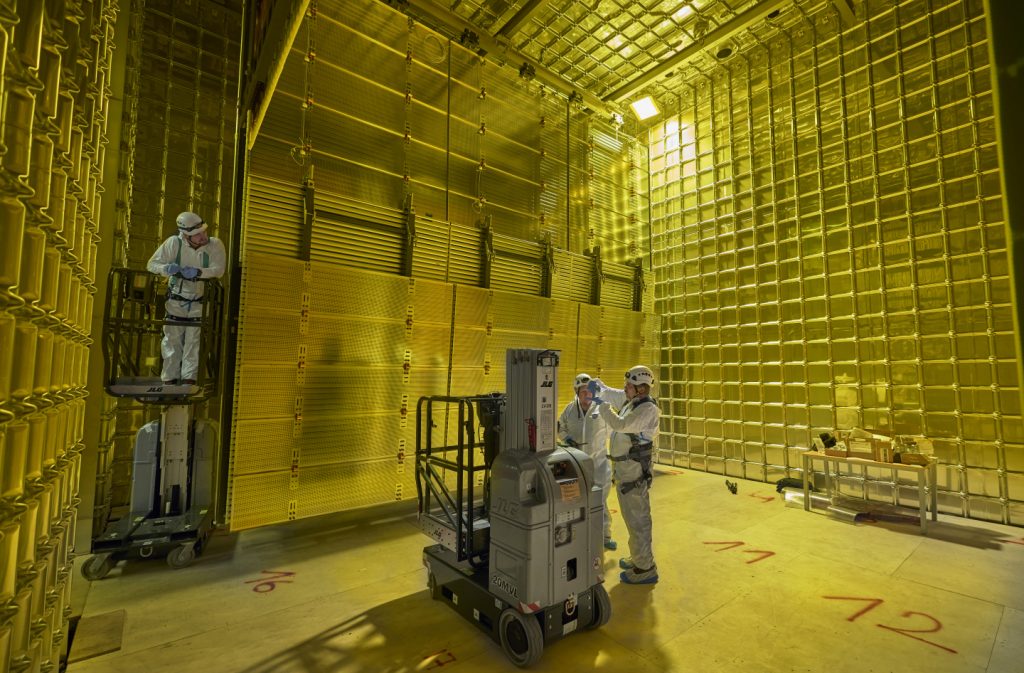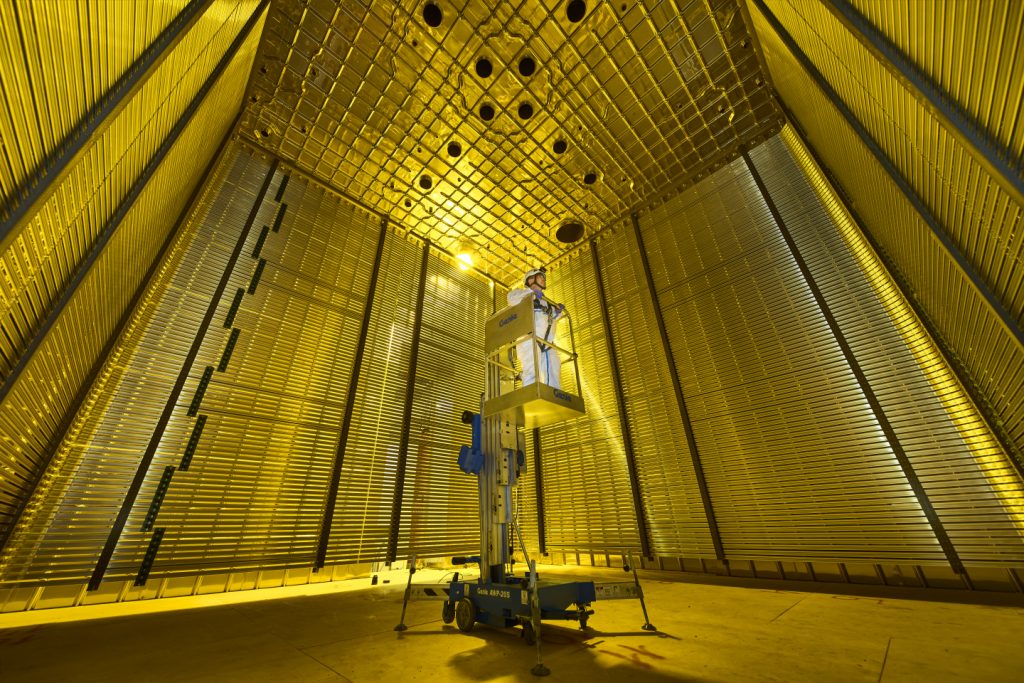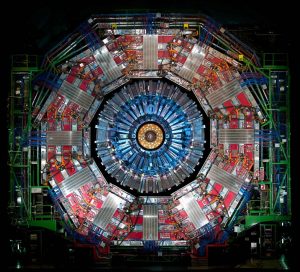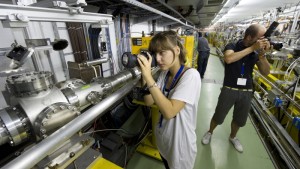 [Update: Registration is now closed. Thank you to all of the interested photographers.]
[Update: Registration is now closed. Thank you to all of the interested photographers.]
Calling all photographers! Registration is now open for the 2018 Photowalk at the U.S. Department of Energy’s Fermi National Accelerator Laboratory.
On July 28, Fermilab will open its doors to 50 amateur and professional photographers for a four-hour behind-the-scenes Photowalk of the laboratory. Photographers will be able to visit, explore and take pictures of scientific machines and locations in research areas not usually accessible to the public.
The Fermilab Photowalk is part of the Global Physics Photowalk, hosted this summer at 16 labs around the world. This year’s event will feature labs and institutions in Australia, Europe and Asia as well as four (Fermilab, Brookhaven National Laboratory in New York, Sanford Underground Research Facility in South Dakota and SLAC National Accelerator Laboratory in California) in the United States.
The Global Physics Photowalk will draw from local and national competitions, with the winning national photos submitted to a global judging panel. The top three photos from Fermilab’s event, as chosen by a jury, will be submitted to the global competition organized by the Interactions collaboration.
Participation in the Fermilab Photowalk will be limited to the first 50 photographers to sign up online. Those who participated in the 2015 Photowalk at Fermilab will not be eligible for the 2018 event. Fermilab employees and users, and their families, are also ineligible.
Fermilab will maintain a waiting list to fill in any cancellations. The July 28 event is free of charge and will run from 8 a.m. to 12:30 p.m. For more information and to register online, please visit http://www.fnal.gov/pub/photowalk.
Fermilab is America’s premier national laboratory for particle physics and accelerator research. A U.S. Department of Energy Office of Science laboratory, Fermilab is located near Chicago, Illinois, and operated under contract by the Fermi Research Alliance LLC, a joint partnership between the University of Chicago and the Universities Research Association Inc. Visit Fermilab’s website at www.fnal.gov and follow us on Twitter at @Fermilab.
The DOE Office of Science is the single largest supporter of basic research in the physical sciences in the United States and is working to address some of the most pressing challenges of our time. For more information, please visit science.energy.gov.
The international Deep Underground Neutrino Experiment collaboration, hosted by the U.S. Department of Energy’s Fermilab, continues to grow. During the collaboration meeting at Fermilab from May 14-18, the DUNE Institutional Board admitted two new institutions to the collaboration: the Laboratory of Instrumentation and Experimental Particle Physics, which is the first institution from Portugal to join DUNE, and the University of Bucharest, the second institution from Romania. The collaboration now comprises 1,061 scientists from 175 institutions in 32 countries.
“The DUNE collaboration is growing at a rate of about 100 people per year,” said co-spokesperson Stefan Soldner-Rembold, professor at the University of Manchester in the UK. “About 60 percent of the 175 institutions on DUNE are from outside the United States.”
A substantial portion of the collaboration meeting was devoted to the upcoming operation of two DUNE prototype detectors at the European research center CERN, known as ProtoDUNE, with speakers presenting the updates on the construction happening this spring.
“There has been really remarkable progress,” said DUNE co-spokesperson Ed Blucher, professor at the University of Chicago. “Congratulations to the installation teams at CERN for their incredible efforts on the two ProtoDUNE detectors. Both are on track to collect data that will be important for finalizing the specifications of the liquid-argon detectors for the DUNE experiment.”
In addition to hosting the construction of the prototype detectors, CERN also will provide the cryostat for the first DUNE detector module to be installed at the Sanford Underground Research Laboratory in South Dakota, housed by the Long-Baseline Neutrino Facility that will be constructed at Fermilab and Sanford Lab.
“ProtoDUNE is a fundamental step towards many technological aspects of LBNF/DUNE,” said Marzio Nessi, leader of the CERN Neutrino Platform. “Before embarking on a multikiloton liquid-argon detector about 1.5 kilometers underground at Sanford Lab, we have to prove at the kiloton scale that we master the construction and operation of the large modular cryostats, that we are able to obtain the required purity of the liquid argon, and that we are able to keep the high-voltage electric field inside the detector at the nominal value, without discharges. ProtoDUNE is the first step, which will give us confidence that we are on the right track.”
Filling of the first prototype detector at CERN with liquid argon, known as single-phase ProtoDUNE detector, is anticipated to begin in June.
“Completion of the huge protoDUNE detector in little over two years from approval is an extraordinary achievement by groups on both sides of the Atlantic,” said ProtoDUNE co-leader Christos Touramanis, professor at the University of Liverpool in the UK. “It fills us with confidence that the ambitious DUNE construction schedule will be met.”
The first ProtoDUNE detector will start recording particle tracks later this year.
“It has been an incredible team effort bringing together the ProtoDUNE detector elements constructed in the U.S. and UK,” said ProtoDUNE Construction Coordinator Regina Rameika of Fermilab. “The support we have received from CERN for the installation has been amazing. We are now looking forward to operating the detector.”
The construction of the second prototype detector at CERN, known as the dual-phase ProtoDUNE detector, also is progressing well.
“In the last months, the progress in the construction and test of the various components of the second DUNE prototype detector at CERN has changed gear,” said Filippo Resnati, the technical coordinator of the Neutrino Platform at CERN. “The field cage is fully installed and has been tested at 150,000 volts. In June, the first 3-meter-by-3-meter signal-amplification system will be ready to be extensively tested in realistic thermodynamic conditions. Light readout, electronics, data acquisition and detector control systems are in very good shape too. The installation of the detector will be completed in fall of this year.”
Once it is operational, scientists will record cosmic-ray muons to test the detector.
“We are eagerly looking forward to the completion and the operation of the dual-phase ProtoDUNE detector,” said CNRS Research DIrector Dario Autiero of the French National Institute of Nuclear and Particle Physics. “The innovative design of this prototype is the outcome of a long R&D process. It is aimed at providing DUNE additional handles. The construction effort for this large-scale detector required a strong dedication from many groups and would not have been possible without the fundamental support from CERN.”
Another important topic at the collaboration meeting was the Interim Design Report for the construction of DUNE far detector modules in South Dakota. The document is based on the experience DUNE scientists and engineers gained during the design and construction of the prototype detectors at CERN. It is a step toward the publication of the more detailed Technical Design Report in 2019, which will serve as the blueprint for the construction of the first DUNE far detector modules.
“Within a few months, the recently formed DUNE Far Detector Institutional Consortia — who take responsibility for the construction, installation and commissioning of the different far detector subsystems — were able to provide detailed documentation on the current state of their planning efforts,” said Eric James, DUNE technical coordinator. “Production of the Interim Design Report on such a short time scale sends a strong signal that the collaboration remains on track to meet its goal of producing the Technical Design Reports for the first two far detector modules by spring 2019.”
DUNE now comprises institutions from 32 countries: Armenia, Brazil, Bulgaria, Canada, Chile, China, Colombia, Czech Republic, Finland, France, Greece, India, Iran, Italy, Japan, Madagascar, Mexico, Netherlands, Paraguay, Peru, Poland, Portugal, Romania, Russia, South Korea, Spain, Sweden, Switzerland, Turkey, Ukraine, United Kingdom, and United States. More information is at dunescience.org.
To learn more about the Deep Underground Neutrino Experiment, the Long-Baseline Neutrino Facility that will house the experiment, and the PIP-II particle accelerator project that will power the neutrino beam for the experiment, visit www.fnal.gov/pub/science/lbnf-dune/.
The Higgs field is like an endless ocean through which all matter swims. Some particles are like sponges and sop up mass as they lumber along, while others are as sprightly as tiny minnows and dart right through.
The Higgs theory is a beautifully simple explanation as to why some particles are massive while others are not. But not all predictions of the Higgs theory have been experimentally tested yet. That’s why scientists on the CMS experiment at the Large Hadron Collider are putting the Higgs boson under a microscope and trying to determine how it fits into the delicate ecosystem of particles.
“We know that the Higgs interacts with massive force-carrying particles, like the W boson, because that’s how we originally discovered it,” said scientist Patty McBride from the U.S. Department of Energy’s Fermi National Accelerator Laboratory, which supports the research of hundreds of U.S. scientists on the CMS experiment. “Now we’re trying to understand its relationship with fermions.”
Fermions are particles that click together to form the invisible scaffolding inside atoms. Bosons, on the other hand, are the physical manifestation of forces and perform tasks such as gluing fermions together.
In June 2014, scientists on the CMS experiment published a paper in Nature showing that the Higgs boson has a relationship with fermions by measuring the rate at which it decays into tau leptons, a heavier cousin of the electron. Later, both the CMS and ATLAS experiments found evidence of the Higgs boson decaying into bottom quarks. Now, scientists are tackling its relationship with the top quark.
“The relationship between the Higgs and the top quark is particularly interesting because the top quark is the most massive particle ever discovered,” McBride said. “As the ‘giver of mass,’ the Higgs boson should be enormously fond of the top quark.”
Because the top quark is much more massive than the Higgs boson, it’s impossible for a Higgs boson to decay into a pair of top quarks. Luckily, there is another way to measure how strongly the Higgs boson couples to top quarks: looking for the rare case of simultaneous production of top quarks and a Higgs boson.
“Higgs boson production is rare – but Higgs production with top quarks is rarest of them all, amounting to only about 1 percent of the Higgs boson events produced at the LHC,” said Chris Neu, a physicist at the University of Virginia who worked on this analysis.
In a paper published today in the journal Physical Review Letters, scientists on the CMS experiment report observing a statistically significant abundance of events in which the Higgs boson is produced in association with two top quarks. The CMS result for this rare Standard Model process with a significance of 5.2 sigma constitutes the first observation that exceeds the 5 sigma threshold physicists require. The ATLAS experiment has also submitted a paper on the same phenomenon for publication.
To get these results, the CMS experiment looked for Higgs bosons based on the numerous possible signatures it can leave behind in the detector.
“A top quark decays almost exclusively into a bottom quark and a W boson,” Neu said. “The Higgs boson, on the other hand, has a rich spectrum of decay modes, including decays to pairs of bottom quarks, W bosons, tau leptons, photons and several others. This leads to a wide variety of signatures in events with two top quarks and a Higgs boson. We pursued each of these and combined the results to produce our final analysis.”
Exploring the Higgs boson’s relationship with the top quark further could also be a possible window to new physics, according to Fermilab Deputy Director Joe Lykken.
“Pinning down this coupling will tell us a lot about the behavior of the Higgs and how it might also interact with other particles we haven’t discovered, like dark matter,” Lykken said. “Deeply understanding how the Higgs interacts with known particles could help lead us to physics beyond the Standard Model.”
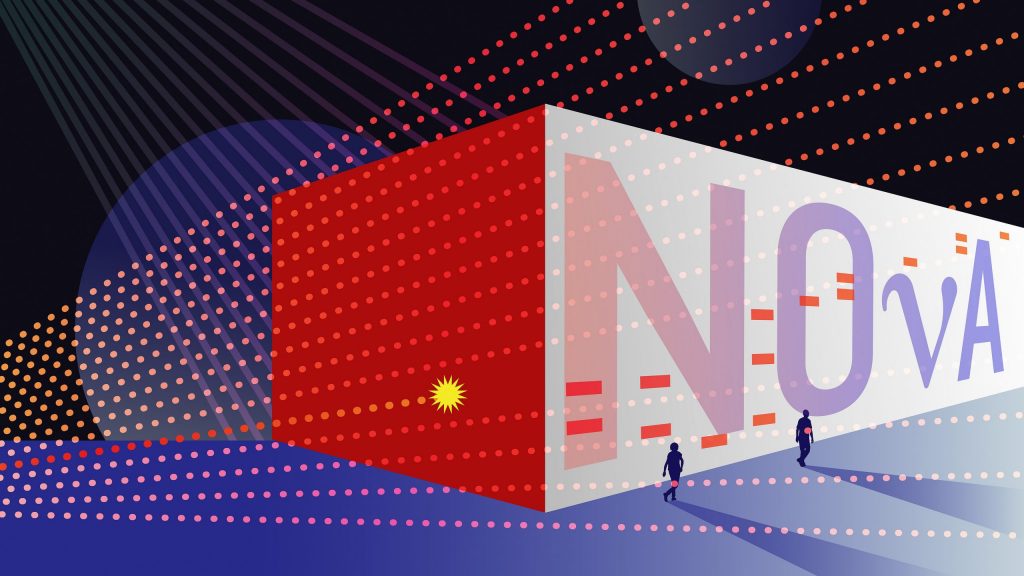
The Fermilab NOvA neutrino experiment announced that it has seen strong evidence of muon antineutrinos oscillating into electron antineutrinos over long distances, a phenomenon that has never been unambiguously observed. Image: Sandbox Studio
For more than three years, scientists on the NOvA collaboration have been observing particles called neutrinos as they oscillate from one type to another over a distance of 500 miles. Now, in a new result unveiled today at the Neutrino 2018 conference in Heidelberg, Germany, the collaboration has announced its first results using antineutrinos, and has seen strong evidence of muon antineutrinos oscillating into electron antineutrinos over long distances, a phenomenon that has never been unambiguously observed.
NOvA, based at the U.S. Department of Energy’s Fermi National Accelerator Laboratory, is the world’s longest-baseline neutrino experiment. Its purpose is to discover more about neutrinos, ghostly yet abundant particles that travel through matter mostly without leaving a trace. The experiment’s long-term goal is to look for similarities and differences in how neutrinos and antineutrinos change from one type — in this case, muon — into one of the other two types, electron or tau. Precisely measuring this change in both neutrinos and antineutrinos, and then comparing them, will help scientists unlock the secrets that these particles hold about how the universe operates.
NOvA uses two large particle detectors — a smaller one at Fermilab in Illinois and a much larger one 500 miles away in northern Minnesota — to study a beam of particles generated by Fermilab’s accelerator complex and sent through Earth, with no tunnel required.
The new result is drawn from NOvA’s first run with antineutrinos, the antimatter counterpart to neutrinos. NOvA began studying antineutrinos in February 2017. Fermilab’s accelerators create a beam of muon neutrinos (or muon antineutrinos), and NOvA’s far detector is specifically designed to see those particles changing into electron neutrinos (or electron antineutrinos) on their journey.
If antineutrinos did not oscillate from muon type to electron type, scientists would have expected to record just five electron antineutrino candidates in the NOvA far detector during this first run. But when they analyzed the data, they found 18, providing strong evidence that antineutrinos undergo this oscillation.
“Antineutrinos are more difficult to make than neutrinos, and they are less likely to interact in our detector,” said Fermilab’s Peter Shanahan, co-spokesperson of the NOvA collaboration. “This first data set is a fraction of our goal, but the number of oscillation events we see is far greater than we would expect if antineutrinos didn’t oscillate from muon type to electron. It demonstrates the impact that Fermilab’s high-power particle beam has on our ability to study neutrinos and antineutrinos.”
Although antineutrinos are known to oscillate, the change into electron antineutrinos over long distances has not yet been definitively observed. The T2K experiment, located in Japan, announced that it had observed hints of this phenomenon in 2017. The NOvA and T2K collaborations are working toward a combined analysis of their data in the coming years.
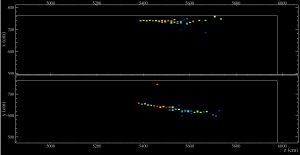
This display shows, from two perspectives, an electron antineutrino appearance candidate in the NOvA far detector. Image courtesy of Evan Niner/NOvA collaboration
“With this first result using antineutrinos, NOvA has moved into the next phase of its scientific program,” said Associate Director for High Energy Physics at the Department of Energy Office of Science Jim Siegrist. “I’m pleased to see this important experiment continuing to tell us more about these fascinating particles.”
NOvA’s new antineutrino result accompanies an improvement to its methods of analysis, leading to a more precise measurement of its neutrino data. From 2014 to 2017, NOvA saw 58 candidates for interactions from muon neutrinos changing into electron neutrinos, and scientists are using this data to move closer to unraveling some of the knottiest mysteries of these elusive particles.
The key to NOvA’s science program is comparing the rate at which electron neutrinos appear in the far detector with the rate that electron antineutrinos appear. A precise measurement of those differences will allow NOvA to achieve one of its main science goals: to determine which of the three types of neutrinos is the heaviest and which the lightest.
Neutrinos have been shown to have mass, but scientists have not been able to directly measure that mass. However, with enough data, they can determine the relative masses of the three, a puzzle called the mass ordering. NOvA is working toward a definitive answer to this question. Scientists on the experiment will continue studying antineutrinos through 2019 and, over the following years, will eventually collect equal amounts of data from neutrinos and antineutrinos.
“This first data set from antineutrinos is a just a start to what promises to be an exciting run,” said NOvA co-spokesperson Tricia Vahle of William & Mary. “It’s early days, but NOvA is already giving us new insights into the many mysteries of neutrinos and antineutrinos.”
For more information on neutrinos and neutrino research, please visit http://neutrinos.fnal.gov.
The NOvA collaboration includes more than 240 scientists from nearly 50 institutions in seven countries: Brazil, Colombia, Czech Republic, India, Russia, the UK and the United States. For more information visit the experiment’s website at http://novaexperiment.fnal.gov.
Fermilab is America’s premier national laboratory for particle physics and accelerator research. A U.S. Department of Energy Office of Science laboratory, Fermilab is located near Chicago, Illinois, and operated under contract by the Fermi Research Alliance LLC, a joint partnership between the University of Chicago and the Universities Research Association Inc. Visit Fermilab’s website at www.fnal.gov and follow us on Twitter at @Fermilab.
DOE’s Office of Science is the single largest supporter of basic research in the physical sciences in the United States, and is working to address some of the most pressing challenges of our time. For more information, please visit science.energy.gov.
If you’re fascinated by the weird world of particles — and who isn’t? — check out Fermilab’s newest website: All Things Neutrino. If you’re curious about what neutrinos are, where they come from, what their history is, and why scientists can’t stop studying them, look no further.
The new website has launched just in time for the biggest neutrino conference in the world, Neutrino 2018, where results from neutrino experiments at Fermilab and around the world will be presented. Neutrino 2018 takes place in Germany from June 4-9, and All Things Neutrino is the perfect companion to help understand the findings coming from the conference.

